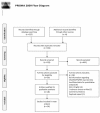Prognostic value of progesterone receptor expression in ovarian cancer: a meta-analysis
- PMID: 28415663
- PMCID: PMC5482703
- DOI: 10.18632/oncotarget.15982
Prognostic value of progesterone receptor expression in ovarian cancer: a meta-analysis
Abstract
Objective: While a prognosis value of progesterone receptor (PR) in ovarian cancer has been reported in some publications, controversial data were presented by different reports. In order to address the disagreement of progesterone receptor in ovarian cancer survival, we conducted this meta-analysis.
Methods: Relevant articles on progesterone receptor and ovarian cancer prognosis were identified via a thorough search of PubMed, Embase and Cochrane Central. Hazard ratios (HR) and 95% confidence interval (CI) were extracted from studies on overall survival (OS) and disease-free survival (DFS)/progress-free survival (PFS)/recurrence-free survival (RFS).
Result: A total of 28 eligible studies containing 5685 patients were collected for analysis. It was found that progesterone receptor positivity was significantly associated with favorable overall survival (OS) (HR = 0.86, 95% CI = 0.78 to 0.95, P = 0.002) and disease-free survival (DFS)/progress-free survival (PFS)/recurrence-free survival (RFS) (HR = 0.75, 95% CI = 0.61 to 0.93, P = 0.008) of ovarian cancer patients. Subgroup analysis showed that progesterone receptor expression was associated with a favorable prognosis of unclassified ovarian cancer, European origin, and immunohistochemical detection method.
Conclusion: Progesterone receptor expression can be used as a favorable prognostic predictor in ovarian cancer managements.
Keywords: meta-analysis; ovarian cancer; progesterone receptor; prognostic.
Conflict of interest statement
The authors have declared no conflicts of interest.
Figures








Similar articles
-
Aldehyde dehydrogenase serves as a biomarker for worse survival profiles in ovarian cancer patients: an updated meta-analysis.BMC Womens Health. 2018 Dec 6;18(1):199. doi: 10.1186/s12905-018-0686-x. BMC Womens Health. 2018. PMID: 30522488 Free PMC article. Review.
-
Prognostic significance of Ki-67 levels and hormone receptor expression in low-grade serous ovarian carcinoma: an investigation of the Tumor Bank Ovarian Cancer Network.Hum Pathol. 2019 Mar;85:299-308. doi: 10.1016/j.humpath.2018.10.020. Epub 2018 Nov 11. Hum Pathol. 2019. PMID: 30428389
-
The prognostic value of CXCR4 in ovarian cancer: a meta-analysis.PLoS One. 2014 Mar 21;9(3):e92629. doi: 10.1371/journal.pone.0092629. eCollection 2014. PLoS One. 2014. PMID: 24658065 Free PMC article.
-
Prognostic Value of Circulating Tumor Cells in Ovarian Cancer: A Meta-Analysis.PLoS One. 2015 Jun 22;10(6):e0130873. doi: 10.1371/journal.pone.0130873. eCollection 2015. PLoS One. 2015. PMID: 26098665 Free PMC article.
-
Prognostic value of vascular endothelial growth factor expression in women with ovarian cancer: A meta-analysis.J BUON. 2015 May-Jun;20(3):870-8. J BUON. 2015. PMID: 26214642 Review.
Cited by
-
The Flavonoid Baicalein Negatively Regulates Progesterone Target Genes in the Uterus in Vivo.J Nat Prod. 2022 Jan 28;85(1):237-247. doi: 10.1021/acs.jnatprod.1c01008. Epub 2021 Dec 22. J Nat Prod. 2022. PMID: 34935393 Free PMC article.
-
Molecular Management of High-Grade Serous Ovarian Carcinoma.Int J Mol Sci. 2022 Nov 9;23(22):13777. doi: 10.3390/ijms232213777. Int J Mol Sci. 2022. PMID: 36430255 Free PMC article. Review.
-
How Progesterone Receptor Expression Impacts Platinum Sensitivity in Ovarian Clear Cell Carcinoma: Insights from Clinical and Experimental Perspectives.Int J Mol Sci. 2024 Jul 20;25(14):7942. doi: 10.3390/ijms25147942. Int J Mol Sci. 2024. PMID: 39063185 Free PMC article.
-
Ecological and evolutionary dynamics to design and improve ovarian cancer treatment.Clin Transl Med. 2024 Sep;14(9):e70012. doi: 10.1002/ctm2.70012. Clin Transl Med. 2024. PMID: 39210542 Free PMC article. Review.
-
Role of NRF2 in Ovarian Cancer.Antioxidants (Basel). 2022 Mar 30;11(4):663. doi: 10.3390/antiox11040663. Antioxidants (Basel). 2022. PMID: 35453348 Free PMC article. Review.
References
-
- Siegel RL, Miller KD, Jemal A. Cancer statistics, 2016. CA Cancer J Clin. 2016;66:7–30. - PubMed
-
- Chudecka-Głaz AM. ROMA, an algorithm for ovarian cancer. Clin Chim Acta. 2015;440:143–151. - PubMed
-
- Chang SJ, Bristow RE, Ryu HS. Impact of complete cytoreduction leaving no gross residual disease associated with radical cytoreductive surgical procedures on survival in advanced ovarian cancer. Ann Surg Oncol. 2012;19:4059–4067. - PubMed
-
- Banerjee S, Kaye SB. New strategies in the treatment of ovarian cancer: current clinical perspectives and future potential. Clin Cancer Res. 2013;19:961–968. - PubMed
Publication types
MeSH terms
Substances
LinkOut - more resources
Full Text Sources
Other Literature Sources
Medical
Research Materials

